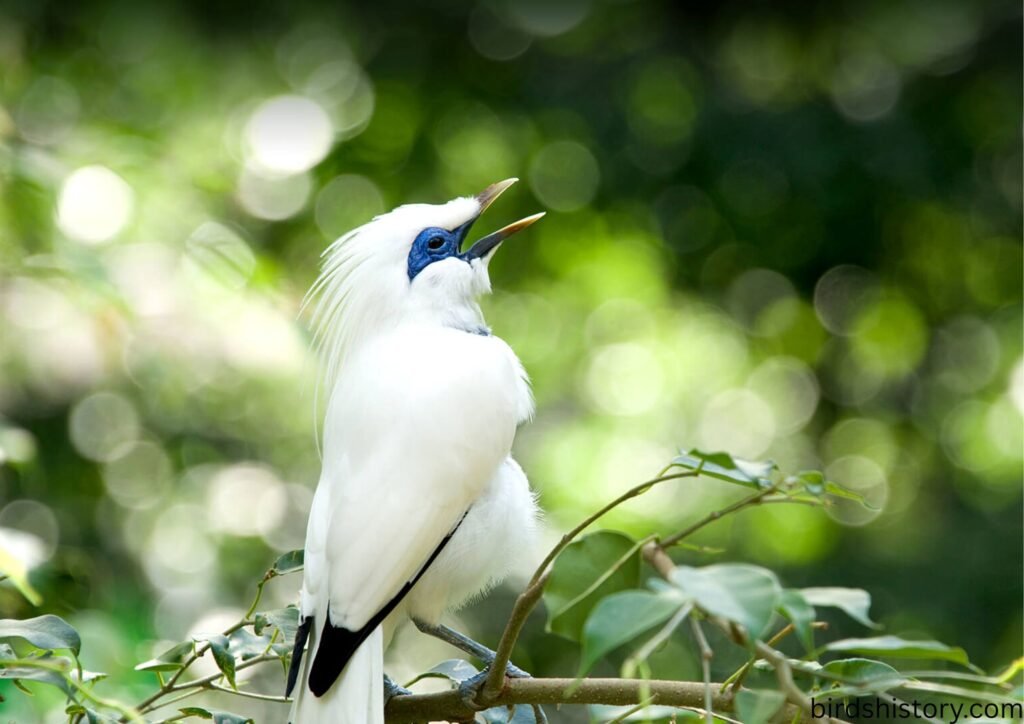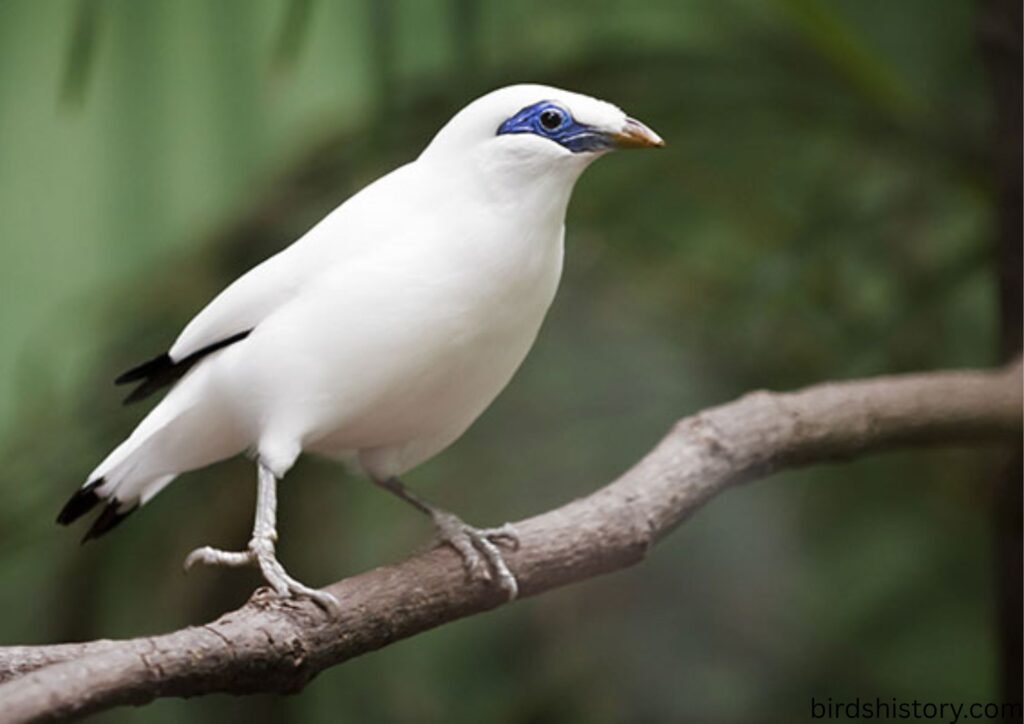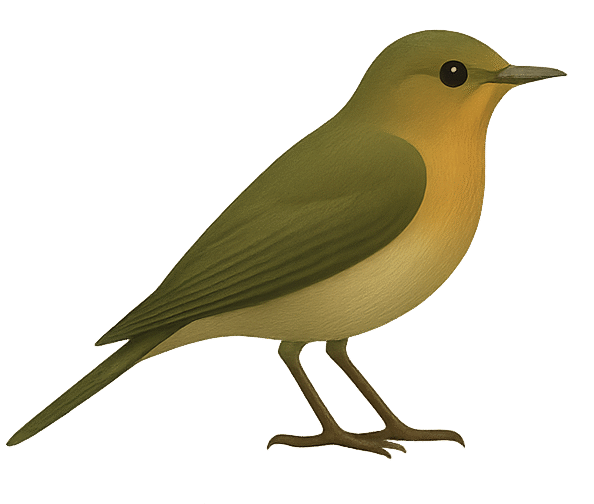Bali Starling: The Rare Jewel of Indonesia’s Wildlife
The Bali Starling is one of the rarest and most striking birds in the world. Native only to the island of Bali in Indonesia, this snow-white songbird has become a powerful symbol of both natural beauty and the urgent need for conservation. Known locally as Jalak Bali, it is famous for its elegant white plumage, vivid blue eye patch, and delicate black-tipped wings and tail.
What makes this bird even more fascinating is its story of survival. Once on the brink of extinction, with fewer than 20 left in the wild during the 1990s, the Bali Starling has since become a global conservation icon. Today, efforts by local communities and international organizations have helped increase its numbers, though it still remains critically endangered.
Let’s explore everything about this extraordinary bird—from its appearance and behavior to its challenges and conservation status.
Taxonomy / Classification
- Common Name: Bali Starling (also known as Bali Myna or Rothschild’s Myna)
- Scientific Name: Leucopsar rothschildi
- Family: Sturnidae
- Order: Passeriformes
- Class: Aves
Also read: /the-resplendent-quetzal/
The species was first described in 1912 by British ornithologist Walter Rothschild, who lent his name to its scientific classification.
Physical Description
The Bali Starling is a bird that captures attention immediately:
- Plumage: Pure white feathers covering its body, symbolizing purity and elegance.
- The Bali Starling has vivid, cobalt-blue skin without feathers around its eyes, which gives it a striking and dramatic appearance.
- Beak: Pale yellow with a slightly curved tip, perfect for feeding on fruits and insects.
- Wings and Tail: Accented with elegant black tips, adding contrast to the all-white body.
- This bird has a soft plume of feathers on its head that it can raise when it’s excited or feels threatened.
The Bali Starling is a bird that’s approximately 25 centimeters (10 inches) long. Both males and females look very similar, making it difficult to distinguish them visually. However, males are usually slightly larger and more vocal.

Habitat and Range
The Bali Starling is an endemic species, meaning it is found only in Bali, Indonesia. More specifically:
- Natural Habitat: Dry monsoon forests, open woodlands, and savannah-like areas of Bali’s northwestern region.
- Geographic Range: Originally spread across much of Bali, but today its wild population is restricted mainly to Bali Barat National Park.
- This animal thrives in tropical environments that have distinct wet and dry periods.
Unlike migratory birds, the Bali Starling does not travel far. It is a resident bird, staying in the same general area year-round.
Diet and Feeding Habits
The Bali Starling is an omnivorous bird with a flexible diet:
- Primary Diet: Fruits, berries, and seeds.
- Secondary Diet: Small insects, caterpillars, ants, and grasshoppers, especially during breeding season when protein is essential.
- They find their food both on the ground and in trees, often jumping from one branch to another as they search for a meal.
An interesting behavior is that they prefer feeding in pairs or small groups rather than large flocks, which makes them harder to spot in the wild.
Behavior and Lifestyle
- Social Structure: Bali Starlings are usually found in small flocks or family groups, though solitary individuals are also common.
- Flight Style: Strong, direct, and fairly quick, but they prefer short flights between trees rather than long-distance flying.
- Calls and Songs: Their vocalizations are loud and varied, including whistles, chattering, and squawks. They are known for their ability to mimic other bird calls.
- Mating Rituals: During courtship, males perform a display by fluffing their crest, spreading wings, and calling loudly to attract a female.
Reproduction and Lifespan
- Breeding Season: Usually occurs during the rainy season (November–April).
- Nesting: They build nests in tree cavities or sometimes use abandoned woodpecker holes.
- The female of this species typically lays a clutch of two to three pale blue eggs.
- Incubation: Lasts around 14–15 days, shared by both parents.
- Chick Development: Young birds fledge about three weeks after hatching.
The average lifespan for these birds in the wild is 5 to 7 years, but when living in a protected environment with proper care, they can survive for as long as 15 years.
Predators and Threats
The Bali Starling faces multiple dangers:
- Natural Predators: Snakes, monitor lizards, and birds of prey (such as hawks and eagles) often target eggs and young chicks.
- Human Impact:
- Habitat Loss: Deforestation and conversion of land for agriculture have reduced their natural habitat.
- Illegal Pet Trade: Their beauty and rarity make them highly sought after, often fetching thousands of dollars on the black market.
- Poaching: Despite legal protection, poaching has been the single greatest threat to the species.
Conservation Status
The Bali Starling’s status on the IUCN Red List is critically endangered, indicating it faces an extremely high risk of extinction in the wild.
- Wild Population: As of recent counts, fewer than 1,000 individuals exist in the wild.
- Captive Breeding Programs: Zoos and bird parks worldwide, including in Bali, Singapore, and the U.S., have established breeding programs to help restore wild populations.
- Reintroduction Efforts: Birds bred in captivity have been successfully released back into Bali Barat National Park and nearby islands like Nusa Penida.
Conservation is ongoing, but challenges remain due to illegal trade and limited habitat.
Interesting Facts
Here are some fascinating tidbits about the Bali Starling:
- This species holds the distinction of being Bali’s official provincial bird and represents the island’s unique natural heritage.
- Locals call it Jalak Bali and consider it a bird of good luck.
- Each bird can be worth up to $2,000 on the black market, making it one of the most expensive caged birds in the world.
- In 1991, the Bali Starling was featured on Indonesia’s 200-rupiah coin.
- Conservationists sometimes place GPS trackers on released birds to study their movement patterns.
- The Bali Starling is one of the world’s rarest birds, often compared to the giant panda in terms of conservation importance.

Conclusion
The Bali Starling is more than just a beautiful creature; it serves as a powerful symbol of how delicate and vulnerable our planet’s biodiversity truly is. With its snow-white feathers, vibrant blue eyes, and haunting calls, it is a true jewel of Indonesia’s wildlife. But its survival depends on us.
Safeguarding the Bali Starling requires us to protect Bali’s forests, stop the illegal wildlife trade, and provide support to conservation initiatives. Every effort made ensures that future generations can still see this extraordinary bird flying free in its natural home.
FAQs About the Bali Starling
Why is the Bali Starling so rare?
Because of poaching and habitat loss, its numbers dropped dramatically, leaving only a few dozen in the wild during the 1990s.
Where can you see the Bali Starling in the wild?
The best place is Bali Barat National Park, located in northwestern Bali.
Is the Bali Starling protected by law?
Yes. It is legally protected by Indonesian law, but enforcement remains a challenge.
What does the Bali Starling eat?
They eat fruits, seeds, and insects, adapting their diet to seasonal availability.
How many Bali Starlings are left today?
Fewer than 1,000 exist in the wild, though numbers fluctuate due to conservation efforts.
Can you keep a Bali Starling as a pet?
No. Owning one is illegal without special government permits, and the trade is heavily regulated.
How long do Bali Starlings live?
In the wild, their life expectancy is approximately 5 to 7 years, while in a protected captive environment, they can survive for up to 15 years.
Who discovered the Bali Starling?
British ornithologist Walter Rothschild described it in 1912.
Why is it also called the Rothschild’s Myna?
The species was given its name to honor Rothschild, who was the first person to provide a scientific description of it.
What is being done to save the Bali Starling?
Conservation programs, captive breeding, habitat protection, and anti-poaching patrols are in place.







